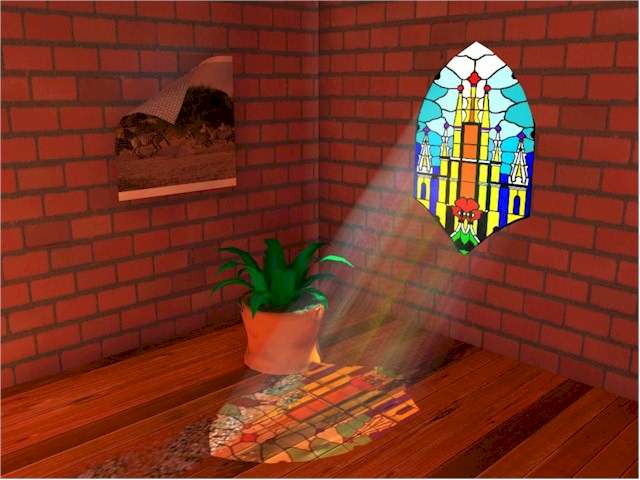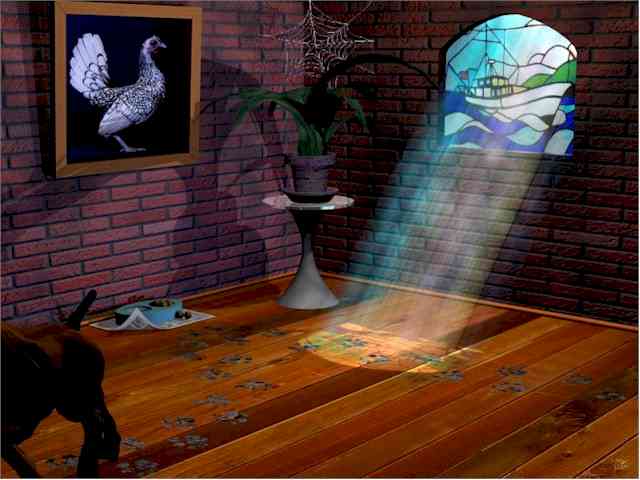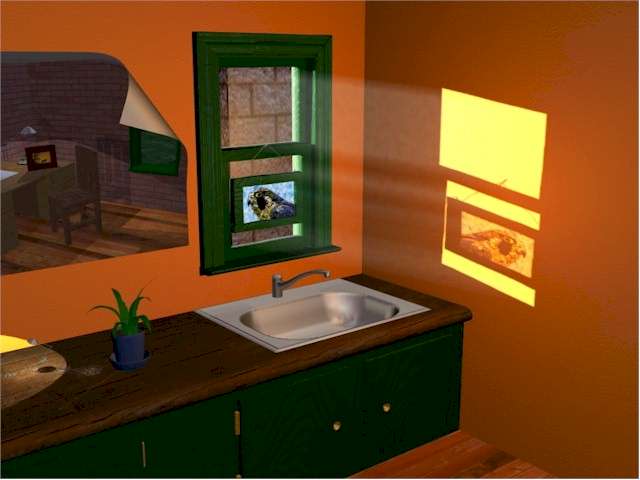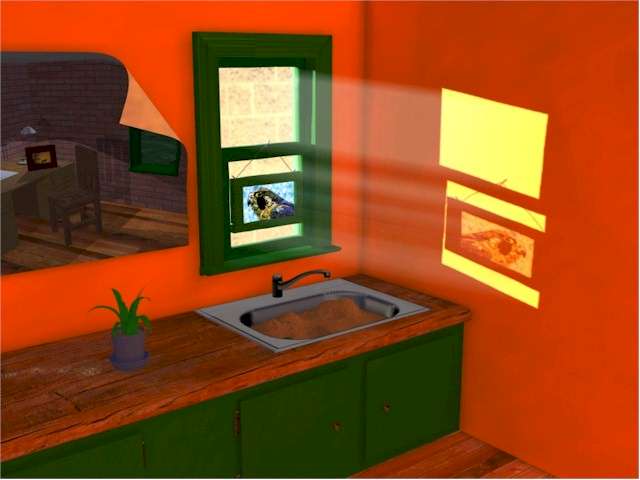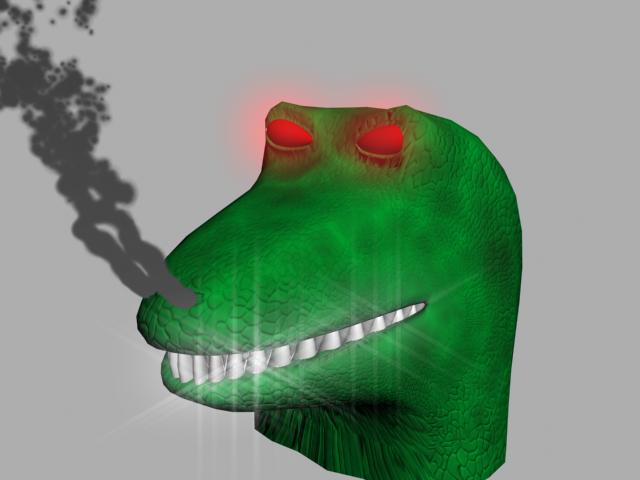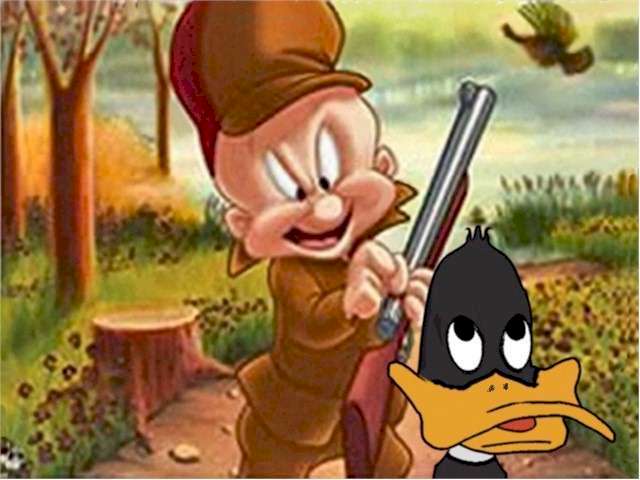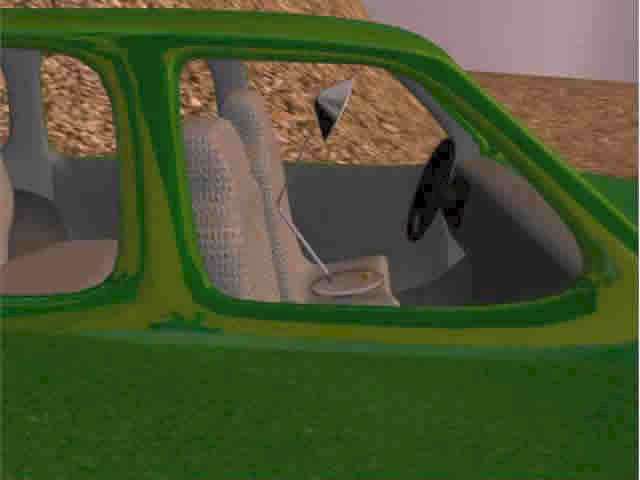Getting Back to Work
Advanced 3D Studio Max ClassEvery man's work is a portrait of himself. - Samuel Butler Project 1: MaterialsOur assignment: To create a floor and two walls; to blend two materials (cedar floor and dirt) which, using a footprint mask, allows the creation of muddy prints on the floor; to create a stained-glass window; to create a two-sided paper that curls (using a bend modifier); to create a potted plant as the product of an array; finally, to create a projector map using the stained glass bitmap and volume lights to create light shafts. We were told to add other lights and perhaps a spider web to complete the picture.
Cody's, mine, Wolf's - his shown first with normal light, then using radiosity In class we learned of various material types available in Max6, including blend, double-sided, top/bottom, morpher, shell, composite, lightscape and architectural; we learned of various texture types such as cellular, dent, speckle, splat, stucco, mask, mix, and thin-wall refraction; we learned about the standard material map types filter colour and displacement for special effects and we were supposed to have a demonstration of new lighting techniques but we didn't have time.
The main lesson I learned from this project is what a huge difference the small finishing touches can make in the quality of the output. I had thought I was done, but was sent back to lighten my stained glass bitmap in Photoshop, to add shadows and darken the room, to add glossiness to my tabletop and noise to the lightshaft - and to put in the retreating dog who'd left the muddy footprints. Wolf and Cody were right - it made for a big improvement and took little extra time. Wolf modelled the scullery in our old house in Wellington. It makes me homesick to look at it.
Project 2: Types of AnimationOur assignment: To create terrain; to draw a path for a dune buggy or four wheel drive vehicle to follow; to make the car follow the path and conform to the terrain along the path; to create a car body and four wheels using attachment and position expression controllers; to add "look at" constraints to the wheels to make them point in the correct directions; to render an animation of the car following along the path. We could optionally make the wheels turn, spend lots of time making a fancy car body, create a particle spray for the rear wheels, and/or use a camera to follow the car around the course. (I used a camera; Wolf and Cody each have a more detailed car body than I - but hey, theirs took a lot longer.)
Cody's, mine, Wolf's - Click to begin In class we learned about animation controllers - there are 32 of them. Several can be applied to a single object and some, like the Euler XYZ Rotation controller, can be split and a separate controller applied to each axis. (I figure it'll take me about 8 years to really get familiar with them all.) We also reviewed the Track View - Curve Editor. The use of controllers points out to me anew that, like web page design, 3D animation doesn't require a single talent - some people specialise in building incredibly realistic models, others are attracted to special effects such as lighting, camera tricks and post production, still more prefer the controller aspect where motion for gaming applications is derived. Some people like to bring the disparate pieces together into a finished scene. A few are good at the basic ideas, the storylines, the concepts. I want to be great at everything - but I'm not. Nevertheless, I enjoy it immensely.
What I learned: First - two Booleans can't cross in any way I could devise without messing them both up. Second - be sure your dune buggy track doesn't have a "crown" in the road because it will make your wheels temporarily fall off (see my animation clip above for an example of what I mean). If your wheels tend to flip over as the vehicle moves along the path, you don't have your x, y and z axes selected correctly in the "Look At Constraint" parameters rollout: just keep trying various combinations. Finally, I learned that, especially when you're a novice as I am, you can be good or you can be fast - but not both. (I'll bet you already knew that, huh?)
Project 3: Box Modelling with MeshsmoothOur assignment: To create a box and convert it to an editable mesh; to "instance" mirror the box so that work on one side is automatically mirrored on the other side; to add progressively finer features; to combine the two halves and smooth the result.
Cody's, mine (only Daffy - Elmer is a 2-D graphic), Wolf's (the car he used in project02 above) In class we learned the basic components of a mesh, how to collapse our stack of modifiers, how to use extrude, clone, scale, and soft selection. We also learned (the easy way by being told or, later, the hard way by forgetting) the importance of always ticking the "ignore backfacing" box. We learned to weld, to fuse, to cut, and how important it is to check for extra vertices or resulting polygons that have more than four sides. (In other words, we learned the importance of being meticulous and careful.)
I've never taken a class in sculpting, though I've always wanted to. I feet like a sculptor using editable meshes - they provide an ideal medium that never dries out or has too much chipped away. I'm a meticulous person, but I'm downright sloppy compared to my son, Wolf. If there's such a thing (ever) as the Mesh Olympics, he could qualify... Click here for:
Click here for:
Click here for:
Click here for:
Plus, there're the Basic 3D classes pages. If you're interested in having a any of the files, please contact me. We used 3D Studio Max version 6 (this was in 2003 after all).
For more animation, video clips, and shockwave games click the "Up" button below to take you to the index page for this Animation section where you will find all sorts of things. |
 Animals
Animals Animation
Animation Art of Playing Cards
Art of Playing Cards Drugs
Drugs Education
Education Environment
Environment Flying
Flying History
History Humour
Humour Immigration
Immigration Info/Tech
Info/Tech Intellectual/Entertaining
Intellectual/Entertaining Lifestyles
Lifestyles Men
Men Money/Politics/Law
Money/Politics/Law New Jersey
New Jersey Odds and Oddities
Odds and Oddities Older & Under
Older & Under Photography
Photography Prisons
Prisons Relationships
Relationships Science
Science Social/Cultural
Social/Cultural Terrorism
Terrorism Wellington
Wellington Working
Working Zero Return Investment
Zero Return Investment